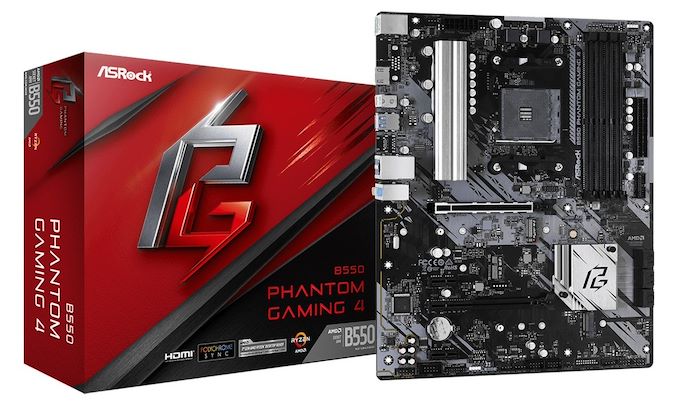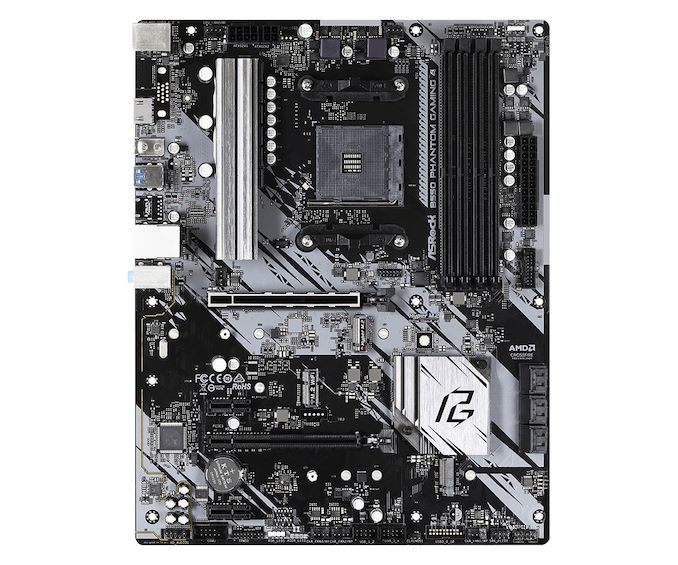The AMD B550 Motherboard Overview: ASUS, GIGABYTE, MSI, ASRock, and Others
by Dr. Ian Cutress & Gavin Bonshor on June 16, 2020 11:00 AM ESTASRock B550 Phantom Gaming 4 + 4ac
For this segment, we’re covering two motherboards: the ASRock B550 Phantom Gaming 4, and the ASRock B550 Phantom Gaming 4ac. The difference between the two, you would think given the name, is that the AC model has Wi-Fi 5 installed. There is another subtle difference, in that the standard PG4 has six SATA ports, whereas the PG4ac model only has four. This is despite both models still having the same PCIe layout, so we’re unsure why there is a difference. Nonetheless the rest of the boards are the same.
As we move to the cheaper end of the B550 range, we move to the motherboards that do not have rear-IO covers, and more limited power delivery and chipset cooling. Despite the PG4 box being red, the board itself is a lot more silver, playing into the Phantom Gaming theme, but with fewer heatsinks there is less to actually cover. For the power delivery here, for example, there is a single heatsink on the left hand side where all six phases for the CPU are. The chipset heatsink is a lot smaller, and neither of the M.2 slots have heatsinks either.
The CPU is powered by an 8-pin and a 4-pin, and the socket area has easy access to three 4-pin fan headers as needed. The motherboard still has a full complement of DDR4 slots, and these are single sided latch variants.
On the right hand side of the motherboard there is a USB 3.0 header, SATA ports, but no power/reset buttons. On the bottom there is an audio header, a COM header, a TPM header, RGB LED headers, three more 4-pin fan headers, two USB 2.0 headers, and a front panel header.
The PCIe layout puts a full PCIe 4.0 x16 slot at the top with additional reinforcement, directly above the PCIe 4.0 x4 M.2 slot for storage. There is an M.2 Wi-Fi slot underneath this, which with the PG4ac is filled with an Intel AC3168 1x1 solution, one of the cheapest 802.11ac modules you can get. There is a full length PCIe 3.0 x4 slot from the chipset, and underneath this is another M.2 slot, this time PCIe 3.0 x2 from the chipset.
The audio section on the right hand side is using an upgraded ALC1200 audio codec, with PCB separation and filter caps. Unlike the other ALC1200 variants we’ve seen from ASRock, this board only has three audio outputs.
On the rear panel we have a combination PS/2 port, six USB 3.2 Gen 1 ports, a HDMI output, and a single Realtek RTL8111H gigabit Ethernet port. There are no USB 3.2 Gen 2 ports on this motherboard.













101 Comments
View All Comments
kpb321 - Tuesday, June 16, 2020 - link
I'm kinda disappointed they ended up missing the opportunity to go PCI-E 4 for the CPU to GPU link. With 2 10gbs USB ports, 2 5gbs USB ports, 10 flexible PCI-E lanes that can be NVME/ Sata ports or add on controllers on the chipset there's plenty of bandwidth there to be bottlenecked by a 4x PCI-E 3 link to the CPU. Going PCI-E 4 would make this somewhat less of a bottleneck and could support for example 2 NVME PCI-E 3.0 4X drives at full speed. The B350 more balanced in this way but sadly it was because the PCI-E off the chipset was only PCI-E 2. Hanging 16x lanes worth of things off a 4x link isn't great when they could have doubled that link bandwidth pretty easily.kpb321 - Tuesday, June 16, 2020 - link
Edit 'm kinda disappointed they ended up missing the opportunity to go PCI-E 4 for the CPU to chipset linkIrata - Tuesday, June 16, 2020 - link
That‘s X570. If you need the additional storage bandwidth, this is what you should go for.Alternatively there is the Aorus board that offers the 8x CPU plus 2x 4x PCIe 4 lanes for nVMe drives plus the PCIe 3 lanes from the chipset. That could be an alternative and eight PCIe 4 lanes for the GPU should be fine with the next gen GPU, except perhaps for the top of the line models.
On the plus side, with Ryzen you have four dedicated PCIe lanes from the CPU for nVMe (16+4+4 vs. 16+4 on Intel).
kpb321 - Tuesday, June 16, 2020 - link
The X570 goes whole hog on PCI-E 4 with PCI-4 hanging off the chipset too and it supports more PCI-E and SATA and USB devices hanging off the chipset so while the CPU to Chipset bandwidth is higher it's actually even more imbalanced between the combine possible bandwidth of devices possible off the chipset and the CPU to Chipset bandwidth.Going PCI-E 4 for just the CPU to Chipset on the B550 would have given the option to decrease that imbalance and one PCI-E 4x link shouldn't have driven the power up too high.
romrunning - Tuesday, June 16, 2020 - link
Then most people wouldn't buy X570 and get B550 instead as there wouldn't be much of a difference. That, and having less PCIe 4.0 stuff lowers the power requirements a bit.I personally held off on X570 because I knew I basically only needed the GPU and NVMe drive to be PCIe 4.0 for the most future-proof setup. I figure I'll buy new again when the new AM5 socket is released with Zen 4. Plus, some of the B550 boards have a Type-C front connector, which will go with the new ITX case I'm getting that has one on the front.
PixyMisa - Wednesday, June 17, 2020 - link
Yes, but then you need to add a separate PCIe controller on the chipset to handle just those 4 lanes. The market probably isn't big enough to make it worthwhile.Irata - Tuesday, June 16, 2020 - link
The CPU to GPU link is 16x PCIe 4.0 - that has nothing to do with the chipset.Or did you mean something else?
a5cent - Friday, June 19, 2020 - link
True, but would that not have brought back the requirement for an actively cooled chipset? That definitely contributes to cost, so it makes sense to cut that from the package.Personally, I'm happy that we've finally left PCIe 2.0 behind. Such chipsets still being sold in 2020 is horrific.
Lucky Stripes 99 - Tuesday, June 16, 2020 - link
I was hoping to build several B550 APU mITX systems this week, but the lack of a compatible APU has stopped those plans. AMD's decision regarding to use a prior generation micro-architecture for its APUs in addition to their decision regarding AM4 firmware size limits are really colliding to create a missed opportunity here. If the iGPU in the Comet Lake processors was better, I'd be picking up H460 or Q470 boards right now instead.DigitalFreak - Tuesday, June 16, 2020 - link
My understanding is that the firmware size limit wasn't created by AMD. The motherboard makers could always use firmware chips with a larger capacity. Intel doesn't have this problem since they only support one or two CPU generations per motherboard :-)